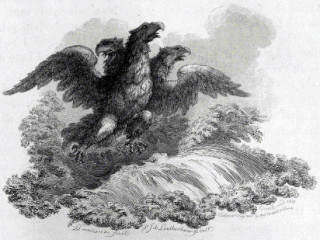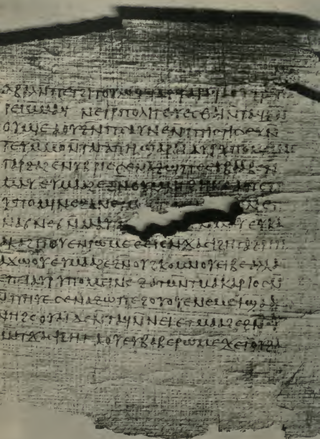
The Bible is a collection of religious texts or scriptures, some, all, or a variant of which are held to be sacred in Christianity, Judaism, Samaritanism, Islam, the Baha'i Faith, and other Abrahamic religions. The Bible is an anthology originally written in Hebrew, Aramaic, and Koine Greek. These texts include instructions, stories, poetry, and prophecies, among other genres. The collection of materials that are accepted as part of the Bible by a particular religious tradition or community is called a biblical canon. Believers in the Bible generally consider it to be a product of divine inspiration, but the way they understand what that means and interpret the text varies.

The Shepherd of Hermas, sometimes just called The Shepherd, is a Christian literary work of the late first half of the second century, considered a valuable book by many Christians, and considered canonical scripture by some of the early Church fathers such as Irenaeus. The Shepherd was popular amongst Christians in the 2nd, 3rd, and 4th centuries. It is found in the Codex Sinaiticus. The Muratorian Fragment identifies the author of The Shepherd as Hermas, the brother of Pius I.

The Gospel of Nicodemus, also known as the Acts of Pilate, is an apocryphal gospel claimed to have been derived from an original Hebrew work written by Nicodemus, who appears in the Gospel of John as an associate of Jesus. The title "Gospel of Nicodemus" is medieval in origin. The dates of its accreted sections are uncertain, but the work in its existing form is thought to date to around the 4th or 5th century AD.

The Book of Enoch is an ancient Hebrew apocalyptic religious text, ascribed by tradition to the patriarch Enoch who was the father of Methuselah and the great-grandfather of Noah. The Book of Enoch contains unique material on the origins of demons and Nephilim, why some angels fell from heaven, an explanation of why the Genesis flood was morally necessary, and a prophetic exposition of the thousand-year reign of the Messiah. Three books are traditionally attributed to Enoch, including the distinct works 2 Enoch and 3 Enoch.

The Gospel of the Hebrews, or Gospel according to the Hebrews, is a lost Jewish–Christian gospel. The text of the gospel is lost, with only fragments of it surviving as brief quotations by the early Church Fathers and in apocryphal writings. The fragments contain traditions of Jesus' pre-existence, incarnation, baptism, and probably of his temptation, along with some of his sayings. Distinctive features include a Christology characterized by the belief that the Holy Spirit is Jesus' Divine Mother and a first resurrection appearance to James, the brother of Jesus, showing a high regard for James as the leader of the Jewish Christian church in Jerusalem. It was probably composed in Greek in the first decades of the 2nd century, and is believed to have been used by Greek-speaking Jewish Christians in Egypt during that century.

The Apocalypse of Peter, also called the Revelation of Peter, is an early Christian text of the 2nd century and a work of apocalyptic literature. It is not included in the standard canon of the New Testament, but is classed as part of New Testament apocrypha. The Apocalypse of Peter is mentioned in the Muratorian fragment, a 2nd-century list of books thought to be canonical in Christianity. The Muratorian fragment expresses some hesitation on the work, saying that some authorities would not have it read in church. The text is extant in two incomplete versions based on a lost Koine Greek original: an edited Greek version and an Ethiopic version, which diverge considerably. It is influenced by both Jewish apocalyptic literature and Hellenistic philosophy from Greek culture. The Apocalypse of Peter is the earliest-written extant document depicting a Christian version of heaven and hell in detail.
The Testament of Adam is a Christian work of Old Testament pseudepigrapha that dates from the 2nd to 5th centuries AD in origin, perhaps composed within the Christian communities of Syria. It purports to relate the final words of Adam to his son Seth; Seth records the Testament and then buries the account in the legendary Cave of Treasures. Adam speaks of prayer and which parts of Creation praise God each hour of the day; he then prophesies both the coming of the Messiah and the Great Flood; and finally, a description of the celestial hierarchy of angels is given.
The Life of Adam and Eve, also known in its Greek version as the Apocalypse of Moses, is a Jewish apocryphal group of writings. It recounts the lives of Adam and Eve from after their expulsion from the Garden of Eden to their deaths. It provides more detail about the Fall of Man, including Eve's version of the story. Satan explains that he rebelled when God commanded him to bow down to Adam. After Adam dies, he and all his descendants are promised a resurrection.
The Clementine literature is a late antique third-century Christian romance or "novel" containing a fictitious account of the conversion of Clement of Rome to Christianity, his subsequent life and travels with the apostle Peter and an account of how they became traveling companions, Peter's discourses, and finally Clement's family history and eventual reunion with his family. To reflect the pseudonymous nature of the authorship, the author is sometimes referred to as Pseudo-Clement. In all likelihood, the original text went by the name of Periodoi Petrou or Circuits of Peter; sometimes historians refer to it as the "Basic Writing" or "Grundschrift".

The New Testament apocrypha are a number of writings by early Christians that give accounts of Jesus and his teachings, the nature of God, or the teachings of his apostles and of their lives. Some of these writings were cited as scripture by early Christians, but since the fifth century a widespread consensus has emerged limiting the New Testament to the 27 books of the modern canon. Roman Catholic, Eastern Orthodox, and Protestant churches generally do not view the New Testament apocrypha as part of the Bible.

2 Esdras is an apocalyptic book in some English versions of the Bible. Tradition ascribes it to Ezra, a scribe and priest of the fifth century BC, whom the book identifies with the sixth-century figure Shealtiel.

The Acts of Peter is one of the earliest of the apocryphal Acts of the Apostles in Christianity, dating to the late 2nd century AD. The majority of the text has survived only in the Latin translation of the Codex Vercellensis, under the title Actus Petri cum Simone. It is notable for a description of a miracle contest between Saint Peter and Simon Magus, the first record of the tradition that Saint Peter was crucified head-down, and as the origin of the saying Quo vadis?

The Acts of Andrew, is a Christian apocryphal work describing acts and miracles of Andrew the Apostle. It is alluded to in a Coptic 3rd-century work titled the Manichaean Psalm Book, so it must have been composed prior to that century. By the 4th century, the stories told in the book were considered apocryphal, and the book was relegated to the New Testament apocrypha.

The Apocalypse of Thomas is a work from the New Testament apocrypha, apparently composed originally in Greek. It concerns the end of the world, and appears to be influenced by the Apocalypse of John, although it is written in a less mystical and cosmic manner. The Apocalypse of Thomas is the inspiration for the popular medieval millennial list Fifteen Signs before Doomsday.

The Gnostic Apocalypse of Peter, also known as the Coptic Apocalypse of Peter and Revelation of Peter, is the third tractate in Codex VII of the Nag Hammadi library. The work is part of Gnosticism, a sect of early Christianity, and is considered part of the New Testament apocrypha. It was likely originally written in the Koine Greek language and composed around 200 CE. The surviving manuscript from Nag Hammadi is a poor-quality translation of the Greek into Coptic, and likely dates from the 4th century.

The Apocalypse of Paul is a fourth-century non-canonical apocalypse and part of the New Testament apocrypha. The full original Greek version of the Apocalypse is lost, although fragmentary versions still exist. Using later versions and translations, the text has been reconstructed, notably from Latin and Syriac translations, the earliest being a seventh-century Iranian Syriac codex known as Fonds Issayi 18.

The Epistle of the Apostles is a work of New Testament apocrypha. Despite its name, it is more a gospel or an apocalypse than an epistle. The work takes the form of an open letter purportedly from the remaining eleven apostles describing key events of the life of Jesus, followed by a dialogue between the resurrected Jesus and the apostles where Jesus reveals apocalyptic secrets of reality and the future. It is 51 chapters long. The epistle was likely written in the 2nd century CE in Koine Greek, but was lost for many centuries. A partial Coptic language manuscript was discovered in 1895, a more complete Ethiopic language manuscript was published in 1913, and a full Coptic-Ethiopic-German edition was published in 1919.
Martyrdom of Polycarp is a manuscript written in the form of a letter that relates the religious martyrdom of Polycarp, Bishop of Smyrna and disciple of John the Apostle in the 2nd century AD. It forms the earliest account of Christian martyrdom outside of the New Testament. The author of Martyrdom of Polycarp is unknown, but it has been attributed to members of the group of early Christian theologians known as the Church Fathers. The letter, sent from the church in Smyrna to another church in Asia Minor at Philomelium, is partly written from the point of view of an eye-witness, recounting the arrest of the elderly Polycarp, the Romans' attempt to execute him by fire, and subsequent miraculous events.
A biblical canon is a set of texts which a particular Jewish or Christian religious community regards as part of the Bible.







